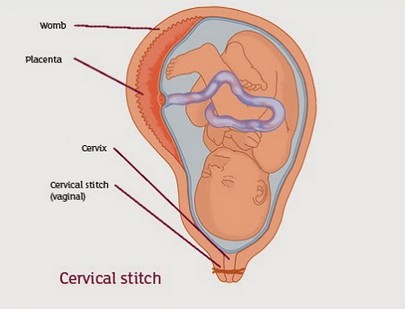Cervical Cerclage Procedure

Contents:
- What is a Cervical Cerclage Procedure?
- Preparation for the Procedure (Operation)
- Risks Associated With Cervical Cerclage
- Removal of the Cerclage Stitch
What is a Cervical Cerclage Procedure?
It is a procedure that is used for the treatment of cervical incompetence (Syndrome of Cervical Insufficiency). It is also known as cervical stitching. Cervical incompetence is a pathological condition in which the cervix shortens or opens well before the end of the pregnancy. Cervical incompetence may also develop if the cervix is weak, which does not allow it to hold a fetus.
The cervix can weaken due to miscarriage in the second trimester or damages that occurred due to early termination of pregnancy or wedge biopsy. The too early opening of the cervix can lead to miscarriage or premature delivery.
A woman may be assigned to cervical cerclage after an ultrasound. In fact, during this procedure, the cervix is stitched. Usually, this procedure is performed in the second trimester, or, to be more precise, in the 12-14 weeks of pregnancy. Cervical cerclage is a surgical procedure that is performed under spinal or epidural anesthesia. In some cases, it is performed under general anesthesia.
This procedure is carried out according to one of the two main methods – McDonald method or Shirodkar method. The first technique involves temporary stitching, and the stitch is removed on the 37th week of pregnancy. Cerclage, performed according to the second method, involves permanent stitching of the cervix. In this case, caesarean section during labor is unavoidable.
Preparation for the Procedure (Operation)

In order to prepare for a cervical cerclage, a woman should undergo transvaginal ultrasound scan. This ultrasound helps to examine the condition of the cervix and determine if the patient is prepared for the cerclage.
The patient is asked to avoid any food and liquids for at least 10-12 hours before the procedure since this can cause nausea and vomiting during anesthesia. Doctors also recommend abstaining from sex, use of tampons and shower for at least 24 hours prior to surgery.
After cervical cerclage patient is being watched for a few hours. This is necessary to ensure that the procedure does not provoke premature labor. In addition, it is advised to stay in bed for a week. You also need to be prepared for a small bleeding and spasms for a few days after the procedure.
Risks Associated With Cervical Cerclage
Although rarely, there may be some risks associated with cervical cerclage:
- Risks associated with anesthesia;
- Early rupture of membranes or premature rupture of waters;
- Amniotic infection;
- Premature birth;
- Laceration of cervix;
- Bladder injuries;
- Bleeding;
- Dystocia of cervix;
- Rupture of the uterus.
Removal of the Cerclage Stitch
According to the methodology of McDonald, cerclage stitch can be removed on the 37-th week of pregnancy. However, some doctors recommend keeping this stitch, because it can help during the carrying of the next pregnancy. Cervical cerclage is certainly a life-saving procedure. It is considered to be the most effective method of treatment of cervical incompetence.
Video: I have an incompetent cervix. How common is a cerclage and bedrest afterwards?